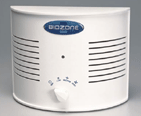Ozone is a main component of the earth’s upper atmosphere, where it is produced during a complex photochemical reaction. It is sometimes referred to as activated oxygen and is produced in the outdoor air during electrical thunderstorms or close to waterfalls. Many scientists have tried to identify the chemical structure of ozone but none of them succeeded to do so up until the middle of the 19th century when Christian Schonbein, a German researcher, named the compound ozone after a Greek word “ozein”. The chemical structure of the compound was set as a triatomic oxygen. This basically means that ozone molecule contains of three oxygen atoms. Therefore ozone is another molecular form of ozygen, having totally different physical and chemical properties.
Biozone air purifier
 Ozone is relatively stable in the air and can be a strong oxidizer in both water and air. According to these properties, ozone has been used since the end of the 19th century in drinking water cleaning methods. As an oxidizer, nowadays ozone is used in many water treatment applications, such as the treatment of municipal water and wastewater, marine waters, swimming pools, beverage businesses, food processing and many others. The purpose of water purification by ozone is not to kill all harmful microorganisms but to keep their numbers down at safe levels to achieve an efficient disease control. Known as an efficient compound in water purification, ozone was introduced into air cleaning systems a few decades ago. It was first used in uninhabited environments, such as fire or flood damaged houses, to prevent from microbial growth there.
Ozone is relatively stable in the air and can be a strong oxidizer in both water and air. According to these properties, ozone has been used since the end of the 19th century in drinking water cleaning methods. As an oxidizer, nowadays ozone is used in many water treatment applications, such as the treatment of municipal water and wastewater, marine waters, swimming pools, beverage businesses, food processing and many others. The purpose of water purification by ozone is not to kill all harmful microorganisms but to keep their numbers down at safe levels to achieve an efficient disease control. Known as an efficient compound in water purification, ozone was introduced into air cleaning systems a few decades ago. It was first used in uninhabited environments, such as fire or flood damaged houses, to prevent from microbial growth there.
Today, ozone is used in cleaning the indoor air in residential areas. This was made possible after the invention of an ozone generator , a device which emits ozone gas at safe concentrations in order to eliminate airborne particles, including dust, pollen, fungi, cat and dog dander, odor and harmful microorganisms from the indoor air. The main principle of ozone action in cleaning the air is a chemical reaction between ozone and airborne pathogens. However, certain by-products are released during the reaction. Even though some manufacturers claim them to be only harmless oxygen, carbon dioxide and water molecules, there is no prove that specific chemical reactions could not form toxic compounds. Biozone air purifiers have been known for over a hundred years due to their advantages in air purification and sanitation processes. Ozone gas acts as a bactericide, viricide, fungicide and deodorizer.
These ozone properties are widely accepted by the scientific community. Ozone, emitted at safe levels, has been known as an efficient odor neutralizer, since it reacts with most of dangerous volatile compounds. Since ozone is a strong oxidizer, it is used to kill airborne microorganisms, including harmful bacteria and viruses, and hence provide a proper infection spread control. However, ozone generators are said to be not efficient enough in clearing the air from dust and mold, and hence manufacturers produce ozone air purifiers combined together with certain types of air filters in order to assure an effective indoor air cleaning. A biozone air purifier could be of greater efficiency in eliminating dust, pollen, mold and tobacco smoke from the air, when constructed with an ionizer. Even though there are a lot of advantages of ozone air purifiers in indoor air cleaning, there is a great concern of the effects of an ozone molecule on people’s health. It is well known that the exposure to high levels of ozone could be harmful to health and can irritate the respiratory system.
Biozone air purifier prevents respiratory diseases
The World Health Organization (WHO) states that high levels of ozone cause throat irritation and cough, decrease in lung function, chest pain, higher susceptibility to respiratory disease and aggravation of asthma. According to such data, there is a great controversy as to the safety of such biozone air purifiers for basic public use. However, there is no consensus to say when ozone levels become harmful to people. A few regulatory agencies, such as the Food and Drug Association (FDA) and the Occupational Safety and Health Administration (OSHA), have set their safety limits for exposure to ozone, based on the available facts. The FDA recommends that the concentrations of ozone should not exceed 0.05 ppm (parts per million) for continual exposure, while OSHA has set 0.1 ppm as a maximum for 8 hour exposure. The firstozone air purifier used to produce ozone levels over these recommendations. Some manufacturers of biozone air purifiers have presented ozone sensors, which shut off the units automatically when ozone levels reach a prescribed limit. These sensors are usually attached to such ozone generators. While this is a step in the right direction, the ozone sensors do not seem to work effectively in all size areas and cannot control high concentrations of ozone while working. In addition, due to excessive cost most manufacturers provide with models without ozone sensors.